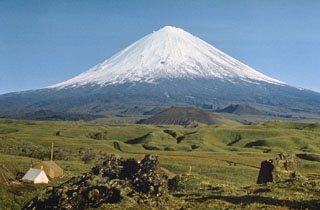Report on Klyuchevskoy (Russia) — 14 December-20 December 2022
Smithsonian Institution / US Geological Survey
Weekly Volcanic Activity Report, 14 December-20 December 2022
Managing Editor: Sally Sennert.
Please cite this report as:
Global Volcanism Program, 2022. Report on Klyuchevskoy (Russia) (Sennert, S, ed.). Weekly Volcanic Activity Report, 14 December-20 December 2022. Smithsonian Institution and US Geological Survey.
Klyuchevskoy
Russia
56.056°N, 160.642°E; summit elev. 4754 m
All times are local (unless otherwise noted)
KVERT reported that the explosive Strombolian eruption at Klyuchevskoy that began on 16 November had decreased. The Kamchatka Branch of Geophysical Services (KBGS; Russian Academy of Sciences) noted that possible ash plumes rose as high as 150 m above the summit on 1 December. KVERT began to characterize the activity as moderate on 6 December and noted that the periodic thermal anomalies identified in satellite images had become weak on 9 December. The Aviation Color Code remained at Yellow (the second lowest level on a four-color scale).
Geological Summary. Klyuchevskoy is the highest and most active volcano on the Kamchatka Peninsula. Since its origin about 6,000 years ago, this symmetrical, basaltic stratovolcano has produced frequent moderate-volume explosive and effusive eruptions without major periods of inactivity. It rises above a saddle NE of Kamen volcano and lies SE of the broad Ushkovsky massif. More than 100 flank eruptions have occurred during approximately the past 3,000 years, with most lateral craters and cones occurring along radial fissures between the unconfined NE-to-SE flanks of the conical volcano between 500 and 3,600 m elevation. Eruptions recorded since the late 17th century have resulted in frequent changes to the morphology of the 700-m-wide summit crater. These eruptions over the past 400 years have originated primarily from the summit crater, but have also included numerous major explosive and effusive eruptions from flank craters.
Sources: Kamchatkan Volcanic Eruption Response Team (KVERT), Institute of Volcanology and Geodynamics, Russian Academy of Natural Science

